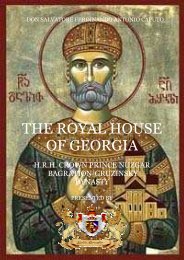here - Nobility Associations
here - Nobility Associations
here - Nobility Associations
You also want an ePaper? Increase the reach of your titles
YUMPU automatically turns print PDFs into web optimized ePapers that Google loves.
Political and military career<br />
Having assumed the title of King of Jerusalem and Sicily, Conradin took possession<br />
of the Duchy of Swabia in 1262, and remained for some time in his dukedom.<br />
Conradin's first invitation to Italy came from the Guelphs of Florence: they asked<br />
him to take arms against Manfred, who had been crowned king of Sicily in 1258 on<br />
a false rumor of Conradin's death. Louis refused this invitation on his nephew's<br />
behalf. In 1266 the count Charles I of Anjou, called by the new pope Clement IV,<br />
defeated and killed Manfred at Benevento, taking possession of southern Italy:<br />
envoys from the Ghibelline cities came then to Bavaria and urged Conradin to come<br />
and free Italy. Count Guido de Montefeltro representing Prince Henry of Castile,<br />
Senator of Rome, offered him the support of the eternal city. Pledging his lands,<br />
Conradin crossed the Alps and issued a manifesto at Verona setting forth his claim<br />
on Sicily.<br />
Notwithstanding the defection of his uncle Louis and of other companions who<br />
returned to Germany, the threats of Clement IV, and a lack of funds, his cause<br />
seemed to prosper. Proclaiming him King of Sicily, his partisans, among them<br />
Prince Henry of Castile, both in the north and south of Italy took up arms; Rome<br />
received his envoy with enthusiasm; and the young king himself received welcomes<br />
at Pavia, Pisa and Siena. In September 1267 a Spanish fleet under Prince Frederick<br />
of Castile, and a number of knights from Pisa, and Spanish knights soldiering from<br />
Tunis, disembarked in the Sicilian city of Sciacca, and most of the island rebelled<br />
against the Angevin rule. Only Palermo and Messina remained loyal to Charles. The<br />
revolt spread to Calabria and Apulia. In November of the same year the Church<br />
excommunicated him; but his fleet won a victory over that of Charles; and in July<br />
1268, Conradin himself entered with immense enthusiasm in Rome.<br />
Having strengthened his forces, he marched towards Lucera to join the Saracen<br />
troops settled t<strong>here</strong> since the time of his grandfather. On 23 August 1268 his multinational<br />
army of Italian, Spanish, Roman, Arab and German troops encountered<br />
that of Charles at Tagliacozzo, in a hilly area of central Italy. The eagerness of<br />
Conradin's Spanish knights under Infante Henry of Castile in the most successful<br />
first charge, and the error to obtaining plunder in the enemy's camp after that<br />
momentary victorious assault gave the final victory to the reinforced French.<br />
Escaping from the field of battle at Tagliacozzo, Conradin reached Rome, but acting<br />
on advice to leave the city he proceeded to Astura in an attempt to sail for Sicily. He<br />
was crossing the sea to Pisa, when he was taken captive with his friends and<br />
companion Frederick of Austria, by Giovanni Frangipani: who delivered him up to<br />
Charles for a large sum of money who imprisoned him in the Castel dell'Ovo in<br />
Naples, together with the inseparable Frederick of Baden. He was tried as a traitor,<br />
The Hohenstaufen Dynasty - Page 82 of 200



